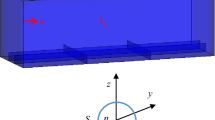Abstract
A simple but precise and physical mechanism-based mathematical expression is proposed to predict shear band trajectories in thick wall cylinders subject to external surrounding pressure. The expression is based on the Coulomb-Mohr fracture criterion and can be applied to various compression-sensitive materials, especially ceramics. The predicted result closely matches the experimental observations, which makes this method quite useful in testing material behavior. This expression also permits the extraction of the parameter μ in the Coulomb-Mohr criterion from experimental observations. Furthermore, no pre-assumptions or after-test measurement are necessary in order to carry out the prediction. The only two values needed to conduct the prediction are the initial inner radius and the friction coefficient μ. A comparison between the newly proposed model and existing theory is made to reveal their relations and demonstrate the effectiveness of the newly derived mathematical expression.
Similar content being viewed by others

References
Nesterenko, V.F., Bondar, M.P., and Ershov, I.V., “Instability of Plastic Flow at Dynamic Pore Collapse,” High-Pressure Science and Technology, S. C. Schnidt, J. W. Shaner, G. A. Samara, and M. Ross, editors AIP Conference Proceedings, Part 2, 1173 (1993).
Nesterenko, V.F., Dynamics of Heterogeneous Materials, Springer-Verlag, New York (2001).
Shih, C.J., Meyers, M.A., Nesterenko, V.F., andChen, S.J., “Damage Evolution in Dynamic Deformation of Silicon Carbide,”Acta Materialia,48,2399–2420 (2000).
Shih, C.J., Nesterenko, V.F., andMeyers, M.A., “High-strain-rate Deformation and Comminution of Silicon Carbide,”Journal of Applied Physics,83 (9),4660–4671 (1998).
Shih, C.J., Meyers, M.A., andNesterenko, V.F., “High-strain-rate Deformation of Granular Silicon Carbide,”Acta Materialia,46, (11),4037–4065 (1998).
Chen, H.C., Lasalvia, J.C., Nesterenko, V.F., andMeyers, M.A., “Shear Localization and Chemical Reaction in High-strain, High-strain-rate Deformation of Ti−Si Powder Mixtures,”Acta Materialia,46 (9),3033–3046 (1998).
Nesterenko, V.F., Meyers, M.A., andChen, H.C., “Shear Localization in High-strain-rate Deformation of Granular Alumina,”Acta Materialia,44 (5),2017–2026 (1996).
Xue, Q., Meyers, M.A., andNesterenko, V.F., “Self-organization of Shear Bands in Titanium and Ti-6Al-4V Alloy,”Acta Materialia,50,575–596 (2002).
Nesterenko, V.F., Meyers, M.A., andWright, T.W., “Self-organization in the Initiation of Adiabatic Shear Bands,”Acta Materialia,46 (1),327–340 (1998).
Espinosa, H.D. andGailly, B.A., “Modeling of Shear Instabilities Observed in Cylinder Collapse Experiments Performed on Ceramic Powders,”Acta Materialia,49,4135–4147 (2001).
Grady, D.E. andKipp, M.E., “The Growth of Unstable Thermoplastic Shear with Application to Steady-wave Shock Compression in Solid,”Journal of the Mechanics and Physics of Solids,35,95–119 (1987).
Wright, T.W. andOckendon, H., “Research Note: A Scaling Law for the Effect of Inertia on the Formation of Adiabatic Shear Bands,”International Journal of Plasticity,12 (7),927–934 (1996).
Molinari, A., “Collective Behavior and Spacing of Adiabatic Shear Bands,”Journal of Mechanical Physics,45 (9)137–141 (1997).
Meyer, M.A., andWang, S.L. “An Improved Method for Shock Consolidation of Powders,”Acta Metallurgica,36 (4),925–936 (1988).
Nesterenko, V.F., Meyers, M.A., andWright, T.W., Metallurgical and Materials Applications of Shock Wave and High-Strain-Rate Phenomena, Elselvier Science, New York, 379–404 (1996).
Johnson, G.R. andHolmquist, T.J. “Response of Aluminum Nitride (Including a Phase Change) to Large Strains, High Rates, and High Pressures.”Journal of Applied Physics,94 (3),1639–1646 (2003).
Holmquist, T.J. andJohnson, G.R., “Response of Silicon Carbide to High Velocity Impact,”Journal of Applied Physics,91,9,5858–5866 (2002).
Johnson, G.R. andHolmquist, T.J., “Response of Boron Carbide Subjected to Large Strains, High Strain Rates and High Pressures,”Journal of Applied Physics,85, (12)8060–8073, (1999).
Ugural, A.C. andFenster, S.K., Advanced Strength and Applied Elasticity, 3rd edition, Prentice-Hall, Upper Saddle River, NJ (1995).
Author information
Authors and Affiliations
Rights and permissions
About this article
Cite this article
Gu, Y., Ravichandran, G. Prediction of incipient shear band trajectories in a thick wall cylinder explosion test. Experimental Mechanics 45, 447–450 (2005). https://doi.org/10.1007/BF02427993
Received:
Revised:
Issue Date:
DOI: https://doi.org/10.1007/BF02427993



